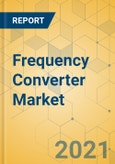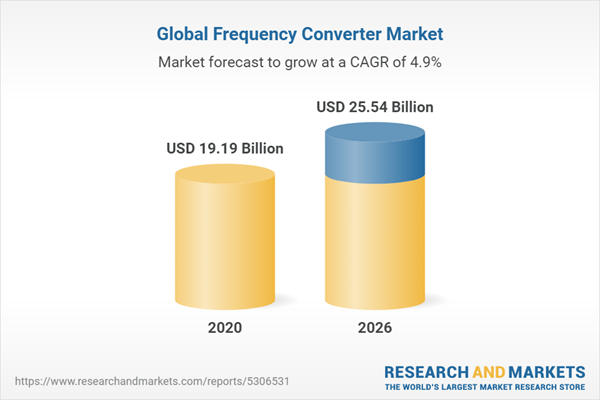Speak directly to the analyst to clarify any post sales queries you may have.
The global frequency converter market by revenue is expected to grow at a CAGR of 5% during 2020-2026.
The market is expected to grow due to the growth in industrial production, technological advancements, urbanization, and industries' expansion. Static frequency converters are expected to witness the highest revenue share by product type, driving the market growth. The market is expected to grow at a stable rate in the short term due to industrial development restrictions; however, the market is anticipated to grow during the forecast period backed by industrial and economic development across the globe. Emerging markets such as APAC and Latin America are expected to witness the highest growth during the forecast period due to or increased investments by developed countries, favorable government policies, and FDIs, and shifting focus toward domestic manufacturing. Automation, robotization, energy conservation, and decarbonization trends are expected to boost frequency converters' demand.
The following factors are likely to contribute to the growth of the frequency converter market during the forecast period:
- The rise in Offshore Wind Electricity Generation Capacity
- High Demand for Automotive Applications
- Development of High-Speed Rails
- Increasing Demand for Water and Wastewater Treatment Plants
The study considers the frequency converter market's present scenario and its market dynamics for the period 2020-2026. It covers a detailed overview of several market growth enablers, restraints, and trends. The report offers both the demand and supply aspects of the market. It profiles and examines leading companies and other prominent ones operating in the market.
Global Frequency Converter Market Segmentation
The global frequency converter market research report includes a detailed segmentation by product type, sales channel, end-user, geography. Static frequency converters are likely to grow at a CAGR of over 5% due to high-frequency stability and output voltage. These devices deliver the required power under fixed conditions in manufacturing units and commercial applications, which are increasing their demand. These machines have low installation costs, and they do not require any heavy machinery and careful alignment. They occupy less space and generate low noise than mechanical converters. Rotary frequency converters (RFC), on the other hand, are observing high application in several end-user segments, including aerospace & defense, rail & hydro facilities, sensitive electronics lab and research centers, process automation, and manufacturing lines. RFCs provide 100% electrical isolation at high-frequency conversions along with vertical and horizontal configurations, thereby observing the demand across the globe. They are highly reliable and can produce high starting surge current for short periods, making them ideal for motor loads. However, they require regular maintenance and have a conversion efficiency of less than 85%.
Direct sales of frequency converters are expected to reach over $22 billion by 2026. Strategic partnerships between vendors and OEMs and vendors and system integrators reduce operational costs. OEMs and system integrators are key contributors to the overall value chain of the frequency converter market. However, new entrants in the market are expected to rely on indirect sales channels, which, in turn, is expected to decrease the usage of direct sales channels. Indirect sale channels include third-party purchases through distributors and dealers. A lack of awareness of brands, variety, and price factors drive customers to opt for indirect sales channels. Although indirect networks do not incur any distribution infrastructure, the price of frequency converters increases via indirect sales channels; hence, they are preferred.
The metal & mining industry generated the highest demand for frequency converters owing to the expansion of mining activities in China, Australia, Brazil, India, the US, and the Middle East. Advances in technology strongly support the growth of the industry; however, due to the COVID-19 pandemic, the demand for metals has become highly uncertain. The metals and mining industry growth is highly unpredictable in the short term; however, it is expected to witness significant growth in the long run. Pumps, conveyors, compressors, fans, and positioning & synchronizations are the major applications of frequency converters in the food and beverage industry. To maintain and boost productivity to satisfy the increasing customer demands for food products, the F&B industry relies heavily on several processing equipment and conveyance systems. Hence, frequency converters are likely to grow in the food industry.
Product Type
- Static
- Rotary
Sales Channel
- Direct
- Indirect
Power Output
- 5-40 KW
- 41-200 KW
- 201-600 KW
- >600 KW
End-user
- Food & Beverage
- Aerospace & Defense
- HVAC
- Pharmaceutical
- Marine
- Metal & Mining
- Chemicals
- Oil & Gas
- Power Generation
- Packaging
- Cement
- Textile
- Water & Wastewater
- Paper & Pulp
- Rubber & Plastic
- Forestry & Woodwork
- Others
Insights by Geography
APAC accounts for the highest share in the global frequency converter market and is expected to grow significantly during the forecast period. China is expected to lead the APAC frequency converter market share and is likely to account for approx. $3 billion by 2026. The increasing number of investments in fully automated industrial machinery and YOY growth in government spending toward defense aircraft and equipment in major economies are the major factors responsible for the market's growth. Moreover, rapid urbanization and increased industrialization in APAC are other major factors driving the region's demand for frequency converter. However, the outbreak of the COVID-19 pandemic has decreased the growth in China from 6% in 2019 to 1.00%-1.50% by the end of 2020. The production in China's chemical manufacturing units declined by over 15%-20% in 2020, which negatively affected the demand for frequency converter from the chemical & petrochemical industry. In the post-COVID landscape, the global economy and production in end-user industries are likely to recover significantly, driving the demand for frequency converters.
Geography
- North America
- US
- Canada
- Europe
- UK
- Germany
- France
- Italy
- Spain
- APAC
- China
- Japan
- South Korea
- India
- Australia
- Latin America
- Brazil
- Mexico
- Chile
- Rest of Latin America
- Middle East & Africa
- Saudi Arabia
- Turkey
- Rest of Middle East
Insights by Vendors
ABB, Aplab, Bosch, Danfoss, and Siemens are the major vendors in the market. Innovations in technology, product lines, marketing strategies, and sales networks are the crucial attributes through which vendors are to be identified and selected. The entry of large companies into the market poses a significant threat to domestic vendors. Large companies are set to explore the market worldwide. Moreover, acquiring technology and commercial distribution is becoming increasingly important for vendors. Changes in local governments' economic policies, laws and regulations, could have an adverse effect on vendors financial stability.
Prominent Vendors
- ABB
- Aplab
- Bosch
- Danfoss
- Siemens
Other Prominent Vendors
- Avish Aviation Equipment
- Aelco
- Avionic Instruments
- Georator
- Jema
- KGS Electronics
- Magnus Power
- MAK Controls
- Nova Electric
- NR Electric
- Piller
- Power System & Control
- Sinepower
- Sojitech
- Westek Electronics
Key Questions Answered
1. What is the frequency converter market size and growth rate during the forecast period?
2. What is the impact of the COVID-19 pandemic on the frequency converter market?
3. What are market opportunities and trends enabling the frequency converter market growth?
4. Which end-user segments are likely to generate the largest revenue during the forecast period?
5. What is the growth of the APAC frequency converter market during the forecast period?
Table of Contents
Companies Mentioned
- ABB
- Aplab
- Bosch
- Danfoss
- Siemens
- Avish Aviation Equipment
- Aelco
- Avionic Instruments
- Georator
- Jema
- KGS Electronics
- Magnus Power
- MAK Controls
- Nova Electric
- NR Electric
- Piller
- Power System & Control
- Sinepower
- Sojitech
- Westek Electronics
Methodology
Our research comprises a mix of primary and secondary research. The secondary research sources that are typically referred to include, but are not limited to, company websites, annual reports, financial reports, company pipeline charts, broker reports, investor presentations and SEC filings, journals and conferences, internal proprietary databases, news articles, press releases, and webcasts specific to the companies operating in any given market.
Primary research involves email interactions with the industry participants across major geographies. The participants who typically take part in such a process include, but are not limited to, CEOs, VPs, business development managers, market intelligence managers, and national sales managers. We primarily rely on internal research work and internal databases that we have populated over the years. We cross-verify our secondary research findings with the primary respondents participating in the study.

LOADING...
Table Information
| Report Attribute | Details |
|---|---|
| Published | March 2021 |
| Forecast Period | 2020 - 2026 |
| Estimated Market Value ( USD | $ 19.19 Billion |
| Forecasted Market Value ( USD | $ 25.54 Billion |
| Compound Annual Growth Rate | 4.8% |
| Regions Covered | Global |
| No. of Companies Mentioned | 20 |









